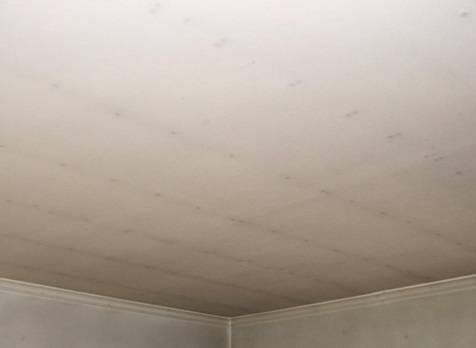Now that we’re solidly into the fall season, leading up to Halloween, I thought I’d tell you a spooky story that’s sure to scare many homeowners. Several months ago, I arrived at a customer’s house to perform preventative maintenance on her furnace. The homeowner met me at the door with a stunned look on her face, and instead of directing me to her basement, she announced very dramatically, “Before you enter, I need to warn you that something sinister has overtaken my house!” That was a statement I hadn’t anticipated from my usually level-headed customer.
Before I could question her further, she guided me into her living room and pointed to her wall. In the bright light of autumn’s early morning sun, I immediately saw what she meant. There was a pattern of straight black lines all the way up and down the outside wall of her room. What’s more, when I glanced at her ceiling, I noticed another faint pattern of black lines traveling across the surface. Each line was perfectly equidistant from the other. Was something creepy lurking in my customer’s house? Was this the next ‘Amityville Horror’ movie in the making, this time located in beautiful Bucks County, PA? I think not!
Take it from the Coop, I’ve been in business a long time, and I’ve seen just about everything that can go wrong in a house so I knew right away what was occurring; her home wasn’t haunted, but I could certainly see evidence of ghosting! That’s right, ghosting!
Ghosting is the result of a slow build-up of soot, dust, dirt, and other particles that have attached to objects such as studs, joists, walls, ceilings, rafters, and even sheetrock screws. To give you some background, let’s talk briefly about the construction of a house. In order to evenly and comfortably heat and cool a home, 3 barriers must surround the building in a continuous fashion to protect it. There must be a moisture barrier, thermal barrier, and an air barrier. These 3 barriers are often called the building envelope. There should never be gaps, penetrations, or voids in this critical building envelope because air and moisture can be carried by air currents through these penetrations which can create problems such as ghosting.
When outside unconditioned air (or inside conditioned air) penetrates the air barrier and moves in and around insulation in the walls, it is called thermal bypass. In the winter, when cold air passes through a badly insulated wall, condensation may occur on the back side of the wall. Sometimes, this leads to a mold issue within the wall cavity. (That’s a BIG problem that I’ll address another day.) At other times, dirt particles stick to these cold, damp spots, and over time, clump together creating the distinctive (and downright creepy) lines that mimic the framing of a wall and/or ceiling. Moreover, differences in indoor vs. outdoor air temperatures can also affect the relative pressure in a home, causing air currents to flow, resulting in, you guessed it, ghosting patterns.
When I described to my customer what caused the ghosting, she became miffed. Her house looked clean and tidy – where was the “dirt” and excess moisture coming from? Interestingly, many sources you’re probably not aware of can cause moisture and dirt including:
- Lit candles – particularly scented types and incense
- Cooking oils that smoke over high heat
- Gas log fireplaces
- Smoking
- Poorly maintained heating/cooling equipment with dirty filters
- Pet dander
- Infrequent vacuuming, dusting, sweeping
- Unvented appliances like cooktops, clothes dryers, and bathroom fans
- Soot from fireplaces and woodstoves
So, now you know what causes ghosting. Here are some things you can do to fix the situation:
- Have a reputable insulation expert make sure your home is properly insulated and fixes any gaps, voids or penetrations.
- Make sure your heating and cooling equipment is cleaned and maintained by a professional company like Cooper Mechanical.
- Replace your air filter on a regular basis, according to the manufacturer’s instructions. You may want to invest in a high quality air filtration system if your air filter can’t seem to keep up with the amount of particle debris in the air.
- If you feel air escaping from your duct work, have a professional technician check it out to ensure there are no leaks on the return and supply sides which can exacerbate pressurization issues.
- Keep the relative humidity in your home below 55% in the winter.
- Make sure appliances are properly vented and be sure to use the venting systems.
- Seal up any cracks or air leaks around windows and doors to mitigate drafts.
- Don’t smoke! (Yet another reason to stop smoking!)
- If you’re addicted to the scent of candles wafting in your home (I sure am) switch to hard wax candles and keep the wicks trimmed to no more than ¼ inch.
- Clean-up and remove wood-burning soot on an ongoing basis.
- Stay on top of the dirt particles in your home. Vacuum, sweep, and dust often.
Once you’ve corrected the issue(s) that are the root cause of the ghosting, then and only then, should you completely clean the affected area, paint over any ghosting marks with a stain-killing paint and then repaint with your top-coat.
Ultimately, my customer had nothing scary to worry about but she did have a good size project to address. It took several months to assess the problems and then fix the issues, but my customer’s home now looks as good as new, with no sign of ghosting!
Is something spooky happening at your house? Don’t be frightened, there’s probably a logical explanation. No need to call ‘Ghost Busters’ – just call Cooper Mechanical for professional assistance at 610-228-4405.






